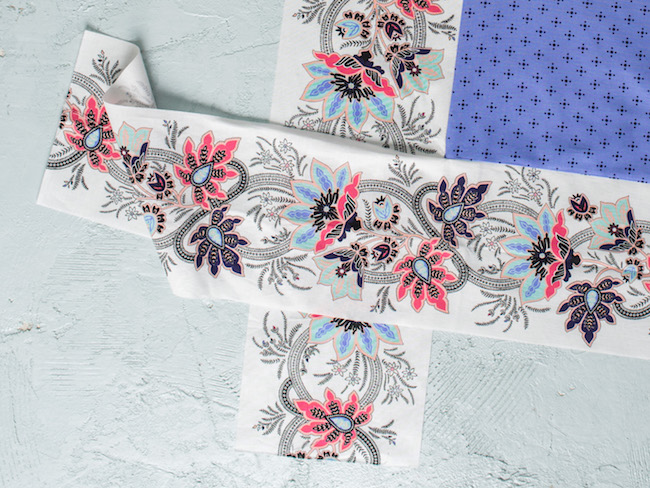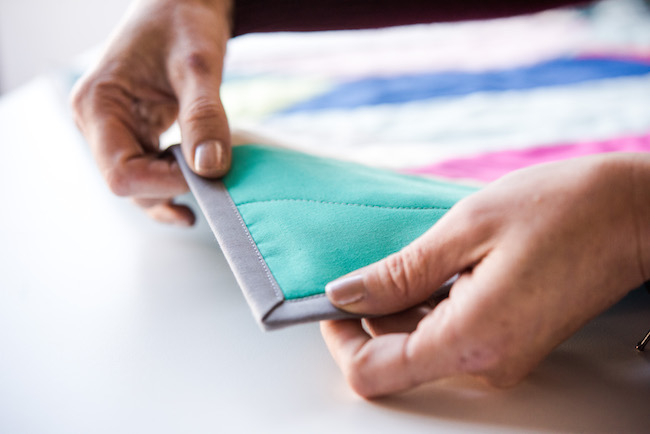There’s nothing worse than binding your quilt and holding it up only to find that the edges of your quilt are wavy rather than hanging nice and straight. If you’ve had this happen to you, you’re probably a) kicking yourself, and b) wondering why it happened.
Wavy borders and bindings can happen to anyone. Luckily, you can take simple steps to ensure they never again happen to you!

First, what causes wavy, rippling borders?
1. The quilt top is longer or wider around the edges than it is the middle.
Instead of a square or a rectangle, think of a subtly curved hourglass shape: the sides are slightly concave, making the edges wider than the measurement across the center.
How to check if your quilt is even all the way around
To check if your quilt is even, measure the quilt horizontally and vertically through the center, then at either edge. If there’s a difference of more than 1″ for smaller quilts or more than a couple inches for larger ones, you might have to make some adjustments.
2. The quilting process alters the measurements of the quilt.
If you’re doing very ornate quilting on the border but a lighter design on the interior, you’re essentially shifting the measurements in your quilt, making the edges more likely to pucker and ripple.
3. You may be stretching the quilt itself or your binding fabric.
Pulling on either of these can result in one being slightly longer than the other and causing the quilt edges to wave.
So, how do I fix the wave?
Sometimes it’s possible to square up your quilt top using a straight edge and a rotary cutter (only if your quilt top isn’t pieced in a block configuration). Most of the time, though, you’ll need to do some adjustments in the quilting process.

Quilting can be the solution to help mold a quilt top into a squarer shape. Here are some tips for adjusting your quilt size with quilting:
- Choose a quilt batting with a higher loft. This provides a cushier, more flexible quilting surface.
- Quilting in one direction can further distort your quilt. Instead, select a quilting pattern or pantograph that moves back and forth rather than just one direction.
- If you’re working on a longarm, load the quilt top with a slight bit of negative ease at the top and bottom, and consider a border design that works from the outside edges in.
- Resist the temptation to “smooth” out the edges of the quilt if they begin to pucker. This only increases the difference between the interior of the quilt and the edges.
Be careful with binding

Finally, just as the quilting process can help or hurt a quilt top that’s slightly askew, binding with care can have a big impact.
If your quilt’s edges are a bit puckered from the quilting process, the binding is a perfect place to hide small pleats and imperfections. Choose a ½” binding (or even slightly larger) to enclose your edges and keep any wonkiness a secret. This approach is far preferable to stretching out your quilt borders and ending up with a wavy, skewed quilt.


My ripples are closer to the center but I find some also in both sides. I've tried the spray and iron it has helped some but the ripples are not gone what else can I do. I am not finished with it and can't proceed until I fix this problem. Can you help me?
My quilts also waved once I’d machine bound them, maybe the presser foot pressure was a bit strong, so I thought I’d try stretching the binding as I sew it on. It presumably contracts back afterwards because it had the desired effect of pulling the waves flat again. Not guaranteed but much better.
I have a quilt that is square and appeared perfectly flat after quilting. I bound the quilt carefully and finished it. I laid it out and was horrified to see how wavy the binding was. I took off the binding and carefully redid it using a walking foot. No small fete since this quilt is 90 inches square. It is better but I still have wavy binding. I am not an inexperienced quilter. It looks to me like the waves occur where the quilting is less dense than the rest of the border. I have scoured the internet looking for how to prevent this on future quilts with no success. Do you have any help for me?